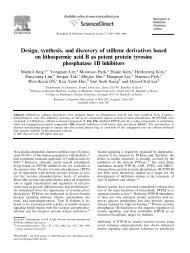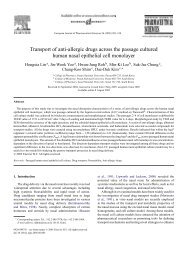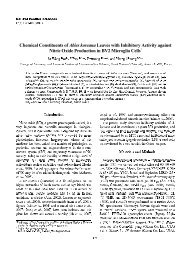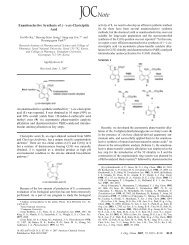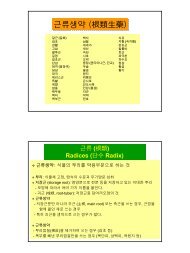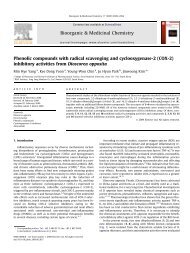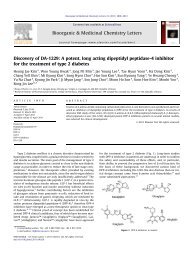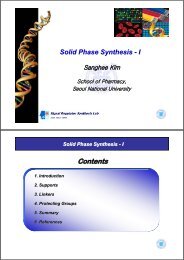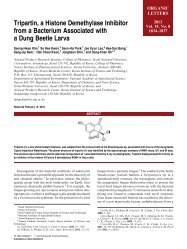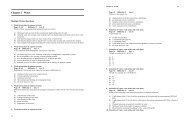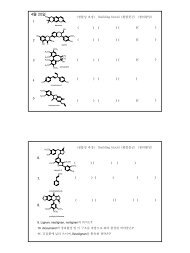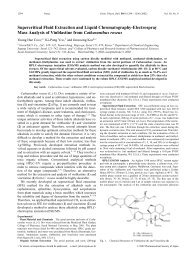Clogging of Drainage Catheters: Quantitative and Longitudinal ...
Clogging of Drainage Catheters: Quantitative and Longitudinal ...
Clogging of Drainage Catheters: Quantitative and Longitudinal ...
You also want an ePaper? Increase the reach of your titles
YUMPU automatically turns print PDFs into web optimized ePapers that Google loves.
Radiology<br />
tive ID, respectively, during the 14-day<br />
follow-up for each irrigation frequency.<br />
Three to 14 days after catheter insertion,<br />
the intracatheter pressure was significantly<br />
lower in catheters with higher irrigation<br />
frequencies than in those with<br />
lower irrigation frequencies. Table 2 summarizes<br />
the results <strong>of</strong> statistical analysis<br />
<strong>of</strong> intracatheter pressure differences at<br />
each irrigation frequency for each observation<br />
during 14-day follow-up.<br />
Microscopic examination <strong>of</strong> the catheters<br />
after they were withdrawn showed<br />
multifocal plugging <strong>of</strong> the side holes <strong>and</strong><br />
catheter lumen with white jellylike<br />
pieces <strong>of</strong> tissue debris <strong>of</strong> various sizes <strong>and</strong><br />
frequencies. Results <strong>of</strong> histopathologic<br />
examination revealed that this tissue debris<br />
was inflammatory exudate that consisted<br />
<strong>of</strong> lymphocytes, plasma cells, neutrophils,<br />
<strong>and</strong> some eosinophils among a<br />
background <strong>of</strong> delicate fibrillary collagenous<br />
material. Results <strong>of</strong> scanning electron<br />
microscopic examination revealed<br />
that this tissue debris had irregular surfaces<br />
(Fig 5), but the catheter surfaces<br />
remained smooth in other areas without<br />
debris.<br />
Figure 2. Graphs show results <strong>of</strong> the in vitro experiment <strong>and</strong> theoretic curves. (a, b) Relationship<br />
between ID <strong>of</strong> a catheter <strong>and</strong> intracatheter pressure (P). Colors <strong>of</strong> the plots <strong>and</strong> curves<br />
indicate a specific preset infusion rate. In a, red 0.1 mL/sec, blue 1.0 mL/sec, orange 2.0<br />
mL/sec, <strong>and</strong> black 3.0 mL/sec. In b, red 0.5 mL/sec, blue 1.5 mL/sec, <strong>and</strong> black 2.5<br />
mL/sec. Data are plotted separately in a <strong>and</strong> b to avoid crowding. Plots indicate the pressures<br />
measured in 48 combinations <strong>of</strong> catheter IDs <strong>and</strong> infusion rates. Solid curves were generated by<br />
fitting Equation (4) derived from the data (plots), <strong>and</strong> the dotted curves represent the ideal curves<br />
generated by the Poiseuille equation (Eq [2]). Note agreement between the data, fitting curves,<br />
<strong>and</strong> ideal curves. A log 10 scale was used to plot P on the y axis.<br />
DISCUSSION<br />
In this study, we evaluated a method<br />
with application <strong>of</strong> the Poiseuille law for<br />
the quantitative <strong>and</strong> longitudinal assessment<br />
<strong>of</strong> catheter clogging during percutaneous<br />
drainage procedures. We verified<br />
the validity <strong>of</strong> this method in two ways:<br />
(a) by performing an in vitro experiment,<br />
in which a series <strong>of</strong> catheters with different<br />
IDs were used to simulate various degrees<br />
<strong>of</strong> obstruction <strong>and</strong> (b) by observing<br />
the results in an in vivo experiment, in<br />
which the degree <strong>of</strong> clogging was graded<br />
according to the irrigation frequency.<br />
Furthermore, our results show that the<br />
effective ID <strong>of</strong> a drainage catheter can be<br />
estimated in vivo by means <strong>of</strong> the mathematically<br />
based approach used in our<br />
study.<br />
To our knowledge, no method has<br />
been reported for evaluating the effectiveness<br />
<strong>of</strong> drainage procedures <strong>and</strong> the<br />
catheters used in such procedures. Our<br />
efforts to develop anticlogging drainage<br />
catheters in recent years have demonstrated<br />
to us that there is a need for an<br />
objective method <strong>of</strong> quantifying catheter<br />
clogging.<br />
We previously determined the degree<br />
<strong>of</strong> catheter clogging in animal models by<br />
means <strong>of</strong> measurement <strong>of</strong> catheter<br />
weight changes, microscopic morphologic<br />
analysis <strong>of</strong> side holes <strong>and</strong> luminal<br />
Figure 3. Graphs show intracatheter pressure changes in 12 rabbits during the 14-day follow-up.<br />
Pressure was measured during the infusion <strong>of</strong> sterile saline at rates <strong>of</strong> (a) 0.1 <strong>and</strong> (b) 0.5 mL/sec.<br />
The degree <strong>of</strong> catheter clogging was graded on the basis <strong>of</strong> the different frequencies <strong>of</strong> manual<br />
irrigation: zero, Πone, two, <strong>and</strong> three times per day. Plots indicate means, <strong>and</strong><br />
error bars represent the st<strong>and</strong>ard errors <strong>of</strong> means. In b, pressures exceeding the measurable limit<br />
(350 mm Hg) <strong>of</strong> the pressure-monitoring device were regarded as 350 mm Hg. Note that degrees<br />
<strong>of</strong> catheter clogging were discriminated by means <strong>of</strong> the pressure measurement system illustrated<br />
in Figure 1. A log 10 scale was used to plot pressure on the y axis.<br />
surfaces, scanning electron microscopy,<br />
or measurement <strong>of</strong> the infusion rate<br />
through a catheter after it was withdrawn.<br />
In our experience, morphologic<br />
analysis is not an effective method because<br />
it is labor intensive <strong>and</strong> tends to<br />
836 Radiology June 2003 Lee et al



